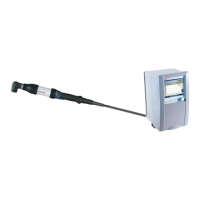506/641 Bosch Rexroth AG | Tightening Technology 3 608 878 300
System 350 | 3 608 878 300/2019-03
Activate the respective data fields.
Fig. 6–78: "Select ID-code filter ..." dialog
Click OK to accept the settings. The dialog is closed and the entries for the ID code mask and ID code
data are generated in the field next to the ID code settings button.
6.13.2.3 Tightening position definition
Each tightening position definition is defined as a line in the table. The following elements are available:
1Byte
2 Masked ID code
3 IP code data
4ID code mask (I)
5Pos (P)
6 K1001 (S)
Table 6–188: Tightening position definition configuration
Element Description
Active The entry for the tightening position definition is activated.
Channel Selection of the channel number of the tightening channel.
Prg Selection of the program number of the tightening program.
Pos Optional: Position
Characteristic identifier
<K2002...>
Characteristic identifier (K2002)
Description Optional: Is not applied for data output.
Graph filter Selection of a graph filter:
– No graph
No graph is transmitted.
–Only OK graph
Graphs for OK tightenings are transmitted.
– Only NOK graph
Graphs for NOK tightenings are transmitted.
– OK and NOK graph
Graphs are always transmitted.
Test plan <K1002> Name/designation of a test plan for this tightening process.
Max. 40 ASCII characters QDA format (80 ASCII characters QDAS format).
OP/Avo <K1086> Designation of the operation/work sequence. Max. 40 ASCII characters
(QDA /QDAS format).
Part number Part number <K1001>:
If no part number is specified, the value of the ID code is used. Otherwise, the
entered value applies.

